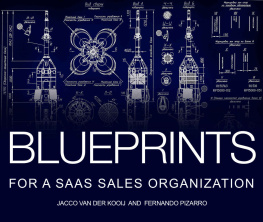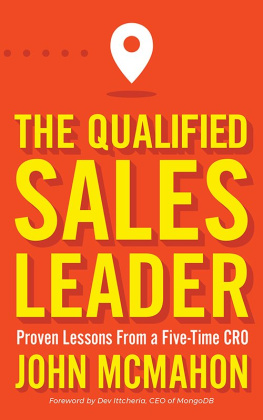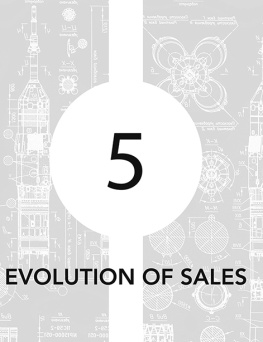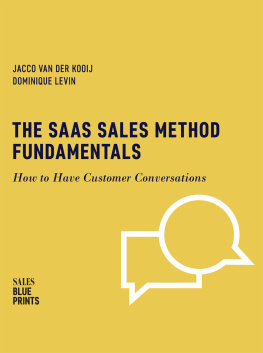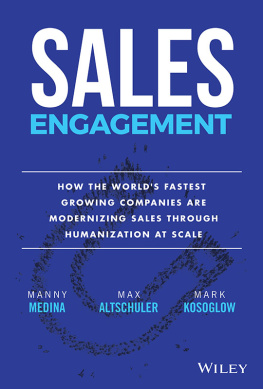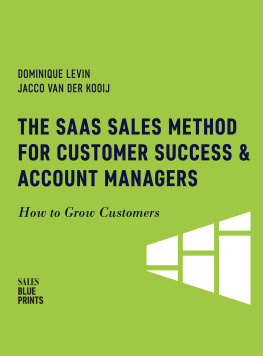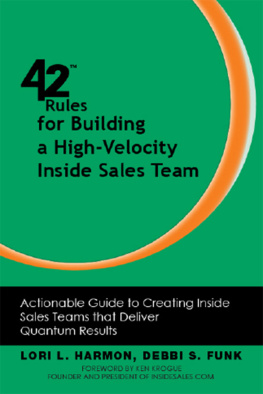Blueprints
the things
we have learned
in sales


People:
AE - Account Executive
AM - Account Manager
BDR - Business Development Representative
CSM - Customer Success Manager
CEO - Chief Executive Officer
CRO - Chief Revenue Officer
CCO - Chief Customer Officer
FAE - Field Account Executive
MDR - Marketing Development Representative
PM - Product Manager
SDR - Sales Development Representative
SE - Sales Engineer, sometimes refers to a web developer
VPM - VP Marketing
VPS - VP Sales
SaaS Lead Definition:
Suspect - A person who may be interested
Prospect - A person who expresses interest
MQL - Marketing Qualified Lead, a person who expresses interest and fits the profile.
SQL - Sales Qualified Lead, person who is interested
SAL - Sales Accepted Lead
WIN - A client who commits to the service
LIVE - Client who has been onboarded
SaaS Business:
ACV - Annual Contract Value
ACRC - Annual Customer Retention Cost
ARR - Annual Recurring Revenue equal to12 times MRR
B2B - Business to Business
B4B - Business for Business
B2C - Business to Consumer
CAC - Client Acquisition Cost, the amount to acquire a single client
CR - Conversion Ratio, the amount of leads to produce one SQL
CRC - Client Retention Cost, the cost to retain a client for 12 months
CRM - Customer Relationship Management (platform)
CSM - Customer Success Management (platform)
ENT - Enterprises, companies with over 5,000 employees
LOGO - Common use term for a high value client
LTV - Life time Value of a client, often between 3- 5 times ACV
MAS - Marketing Automation Software (platform)
MRR - Monthly Recurring Revenue
PTC - Refers to the combined cost of (P)eople, (T)ools, and (C)ontent
RoI - Return on Investment
SaaS - Software as a Service
SC - Sales Cycle
SMB - Small to Medium Business(es) often between 50-500 employees
SME - Small to Medium Enterprise often between 500-5k employees
VSB - Very Small Business often between 2-50 employees
PRO - Prosumer, a single user who behaves like a business user
WR - Win Ratio, the number of accounts it takes to produce one WIN

The lessons contained in this book are the aggregated learning from years spent building sales teams for high growth SaaS startups. As sales leaders and consultants in this constantly changing space we have seen firsthand the effects of building sales teams correctly, which leads to explosive growth, and incorrectly, which almost always leads to an existential crisis.
What we noticed is that the companies that do it right are doing a few things consistently. We have reduced those best practices to a system which we believe sales leaders can implement. The blueprints presented in this book form the basis for that system and for all the work we do to scalably grow revenue. We hope they can do the same for you.
That said, this book is more relevant to some businesses than others. In particular, our blueprints cannot be applied to help you find out your business model, or align it with a strategy*. The lessons contained in this book can only be applied when you are ready to scale your SaaS business. How do you know if you are ready to scale? Read on:
The kind of business you are:
- B2B or B2B2C
- Offering an online service
- With recurring fees
The elements you have in place:
- Your price list is established
- Your first salespeople are in place
- Your target markets are identified and proven
- Your product is nailed down - in short, you are out of beta
The kinds of goals you have:
- Help customers by solving or preventing a problem
- Rapid growth, as measured in monthly revenue
- Increasing valuation of your company
As consultants, our prototypical client meets all of the above criteria. In the shorthand of capital raises, this book is most pertinent to your company if you are post-A round. That is because it is normal for you to still be tinkering with your sales model at A.
In this context, this book lays out step by step instructions to build a scalable customer centric sales organization that will help you develop the revenue stream needed to achieve your hopes and dreams.
* Recommended reading: Aligning Strategy and Sales: The Choices, Systems and Behaviors that Drive Effective Selling by Frank V. Cespedes

In our work helping companies create scalable salesforces, we have identified a recurring problem. The problem is that the way we sell in B2B has made little progress since the early 1900s. As outlined in the book B4B* there may have been several changes in activities from the days of solution selling, and many new tools, but no significant change in the approach and the methodology.
All of us are B2C customers, and today we use that as the point of reference for a great sales experience. This B2C experience provides, instant pricing, peer references, access to online support, and the ability to make a purchase decision without talking to anyone. Try CustomInk.com or Amazon.com and youll see what we mean.
Fast moving markets force B2B customers to look for the same experience, only to find that most B2B providers have a very poor sales experience. There is big gap between the buyers expectations and what they actually experience. This gap is not only big - it seems to be growing.
Do not misunderstand us; great tools are entering the market, from email tracking to workflow management tools and more, all in an attempt to close the gap.
But you cant close that gap by building a 10-story apartment complex on a foundation designed for a single car garage. You need a blueprint that you can work from. A blueprint based on best practices from others that went before you. Because, in a business environment that is moving ever faster, you are most likely to only get one shot at it.

Almost all our clients face this issue: they do not build their teams with process to scale. Instead, they follow a predictable pattern which has been summarized into an industry truism that it takes at least two if not three Sales VPs to get things right.
The first VP takes three to six months to hire. He buys tools on an ad hoc basis to fit the budget. He establishes a once-a-year training program that includes lead development, closing, and negotiation skills. Staff turnover begins because quotas go unmet. Belatedly, he attempts to deploy processes too late.

